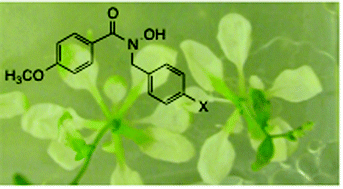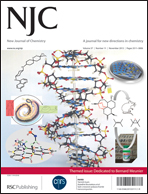Phytotoxic effects of selected N-benzyl-benzoylhydroxamic acid metallo-oxygenase inhibitors: investigation into mechanism of action
Abstract
Treatment of Arabidopsis thaliana with 100 μM hydroxamic acids F1 and F2, found previously to inhibit carotenoid cleavage dioxygenase enzyme CCD1, was found to cause chlorophyll bleaching and phytotoxicity. A further set of hydroxamic acid analogues was synthesised, and these compounds were found to be phytotoxic towards A. thaliana at 16–400 μM, and to show some phytoxicity towards broad-leaved weeds C. album and S. media at 100 μM. Compound F1 was found to inhibit p-hydroxy-phenylpyruvate dioxygenase (HPPD), a known herbicide target (IC50 30 μM), but compounds F5 and F8 showed no inhibition of HPPD, despite F8 showing higher levels of phytotoxicity. Plants grown in the presence of F1 or F5 that were treated with 50 μM homogentisic acid showed partial recovery of growth, indicating some inhibition of HPPD in planta. These are the first hydroxamic acid inhibitors reported for HPPD, but the results indicate that inhibition of HPPD is only partly responsible for the observed phytotoxicity, and that another unknown metalloenzyme is also targeted by these compounds.

- This article is part of the themed collection: In honour of Bernard Meunier

 Please wait while we load your content...
Please wait while we load your content...